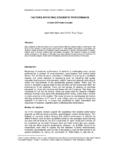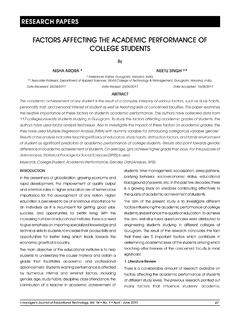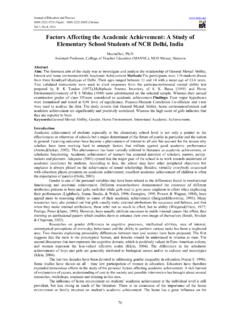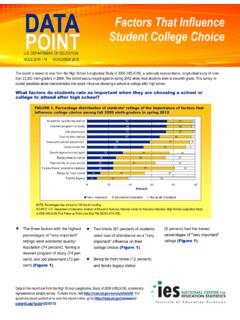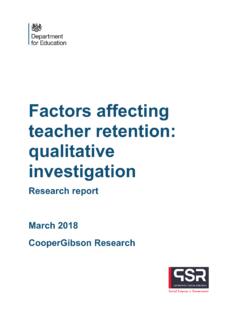Transcription of The Impact of Employment during School on College Student …
1 NBER WORKING PAPER SERIESTHE Impact OF Employment during School ON College STUDENTACADEMIC PERFORMANCEJ effrey S. DeSimoneWorking Paper 14006 BUREAU OF ECONOMIC RESEARCH1050 Massachusetts AvenueCambridge, MA 02138 May 2008I thank the William T. Grant Foundation for funding, Farasat Bokhari and Cagatay Koc for detailedsuggestions, and other participants in a session at the 2006 Southern Economic Association meetingsfor helpful comments. The views expressed herein are those of the author(s) and do not necessarilyreflect the views of the National Bureau of Economic working papers are circulated for discussion and comment purposes.
2 They have not been peer-reviewed or been subject to the review by the NBER Board of Directors that accompanies officialNBER publications. 2008 by Jeffrey S. DeSimone. All rights reserved. Short sections of text, not to exceed two paragraphs,may be quoted without explicit permission provided that full credit, including notice, is given tothe Impact of Employment during School on College Student Academic PerformanceJeffrey S. DeSimoneNBER Working Paper No. 14006 May 2008 JEL No. I2,J22 ABSTRACTThis paper estimates the effect of paid Employment on grades of full-time, four-year students fromfour nationally representative cross sections of the Harvard College Alcohol Study administered during1993 2001.
3 The relationship could be causal in either direction and is likely contaminated by unobservedheterogeneity. Two-stage GMM regressions instrument for work hours using paternal schooling andbeing raised Jewish, which are hypothesized to reflect parental preferences towards education manifestedin additional Student financial support but not influence achievement conditional on maternal schooling, College and class. Extensive empirical testing supports the identifying assumptions of instrument strengthand orthogonality. GMM results show that an additional weekly work hour reduces current year GPAby about points, roughly five times more than the OLS coefficient but somewhat less than recentestimates.
4 Effects are stable across specifications, time, gender, class and age, but vary by health status,maternal schooling, religious background and especially S. DeSimoneDepartment of EconomicsUniversity of Texas at Arlington701 S. West , TX 76019and 11. Introduction Many high School and College students work part-time. Does this affect their School performance? Employment during School could improve grades if working fosters attributes that are complementary with academic success, such as industriousness or time management skills, or instead reduce grades by constraining time and energy available for schoolwork.
5 Alternatively, working might be correlated with academic performance, yet not directly Impact it, if unobserved Student differences influence both labor supply and grades. Unmotivated students might neither work for pay nor receive good grades because they put little effort into the labor market or School . In contrast, students uninterested in academics might work long hours that would otherwise have been devoted to leisure. students might underestimate the link between College achievement and future earnings ( Jones and Jackson, 1990; Loury and Garman, 1995), or any associated positive externalities, when making labor supply decisions.
6 If so, obtaining a consistent estimate of how such decisions affect academic performance is prospectively important for policy consideration. For high School students , much research has been devoted to this question, yielding decidedly mixed evidence. Some studies estimated negative effects of part-time Employment on School performance ( Singh, 1998; Eckstein and Wolpin, 1999; Oettinger, 1999), others showed that grades improve with low work hours but fall with long hours ( Schill et al., 1985; Lillydahl, 1990; Quirk et al., 2001), and still others failed to detect a causal relationship ( Schoenhals et al.)
7 , 1998; Warren et al., 2000; Dustmann et al., 2007). Three recent studies of high School students , all of which used two-stage least squares (2 SLS), illustrate the disparity of conclusions in this literature. Using state child labor laws as instruments in 1992 National Education Longitudinal Study data on high School seniors, Tyler 2(2003) found a large negative effect of additional work hours on standardized test scores. Contradicting this, in annual 1991 2004 Monitoring the Future data on high School seniors, DeSimone (2006) specified components of the Student unearned income distribution as instruments to uncover an inverse U-shaped relationship in which grades peak at 15 weekly work hours.
8 Meanwhile, for National Longitudinal Survey of Youth 1997 (NLSY97) 10th 12th graders, Rothstein (2007) estimated that current and lagged work hours have small negative grade impacts that weaken when individual fixed effects are included and lose significance when instrumented using local wage and unemployment rates and state child labor laws. For College students , the topic has received less attention but seems equally relevant. Many students work specifically to pay for tuition and coursework is presumably more difficult. Observed work propensities and intensities are high. In the 2001 Harvard College Alcohol Study (CAS), 62 percent of respondents reported working for pay in the previous month, and employed students work nearly 29 weekly hours on average.
9 Yet as with high School students , previous research has not reached a consensus on how Employment affects academic performance. Four early studies treat work hours as exogenous. Among 836 students in his 1976 1979 introductory macroeconomics classes at Towson State University, Paul (1982) estimated that 10 additional work hours lowered exam scores by two percent. For 1,933 National Longitudinal Survey males who entered four-year colleges in fall 1972, Ehrenberg and Sherman (1987) found little Impact of work hours on grades. Gleason (1993) depicted evidence of an inverse U-relationship in 1980s data: compared to unemployed students , grade point averages (GPAs) were points higher for those working 1 10 weekly hours but points lower for those working 31 40 weekly hours.
10 Hood et al. (1992) similarly found that students working 7 14 hours per week had higher GPAs than those working less or more. 3 Two recent studies explicitly accounted for the potential endogeneity of hours worked. In 1989 1997 data on 2,372 first semester Berea College students , Stinebrickner and Stinebrickner (2003) use work-study job assignments to instrument for labor supply in a 2 SLS model. An additional weekly work hour reduced first-semester GPA by points. Kalenkoski and Pabilonia (2008) obtained an analogous negative effect of , nearly an order of magnitude smaller, using 1997 2004 NLSY97 data on 1,234 full-time, first semester four-year College students .










